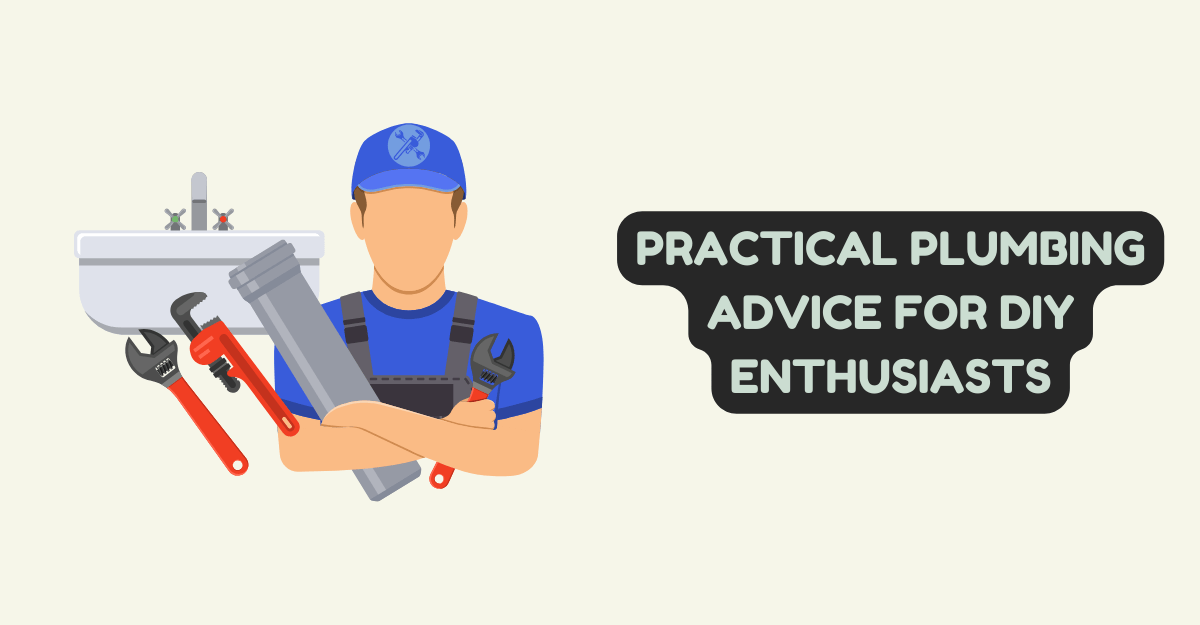
Practical Plumbing Advice for DIY Enthusiasts
Ever find yourself knee-deep in a plumbing problem, considering whether to call a professional or just Do It Yourself? If you’re a DIY enthusiast, this blog post is for you. Here, we’ll dive into some practical plumbing advice to help you handle most household plumbing tasks with confidence and ease.
From identifying common issues to replacing faucets and fixtures to troubleshooting toilet troubles—all in a DIY-friendly manner! For additional detailed tips, check out Dan’s Plumbing Tips. Ready to roll up your sleeves and get down to business? Let’s go!
Essential Plumbing Tools
In the world of DIY plumbing, having the right tools is half the battle won. As the saying goes, “A craftsman is only as good as his tools,” and this couldn’t be truer when it comes to household plumbing projects.
Start by assembling these essential tools: Pipe wrenches (both straight and adjustable), plumber’s tape, pipe cutters, slip joint pliers, and a quality drain snake. Each of these tools serves a unique purpose when tackling various plumbing tasks.
Beyond the above-mentioned basics, it helps to have specialty tools such as basin wrenches for removing faucets and torque wrenches for applying precise pressure. Want to ensure you’re well-prepared for all contingencies? Make sure you also secure the all-purpose plumber’s friend—the plunger!
Last but not least, investing in a well-stocked toolbox ensures you can handle minor fixes smoothly. Remember, high-quality tools translate into durability and efficiency when addressing tasks at hand.
Pipe Cutting Techniques
When it comes to plumbing issues DIY enthusiasts often face is having the right tools for the job. Cutting pipes is near the top of tasks needed to be carried out. Cutting pipes may not sound like a big deal, but it’s actually one of the primary skills you need to master for successful plumbing projects.
There are different methods for cutting pipes, each suitable for different types of pipes and project requirements—such as using a hacksaw, a pipe cutter or a reciprocating saw. These tools can simplify the task at hand and leave a cleaner cut.
Remember that safety should always be your number one priority. Handle sharp tools with care, use goggles to protect your eyes from chips and dust, and make sure your work area is clean and clutter-free before starting the cutting process.
The key is to ensure that the cuts are straight and burr-free. Take your time, be patient, and you’ll get better with practice!
Identifying Common Plumbing Issues
Before you begin your DIY plumbing exploits, it’s crucial to understand the common issues you might face. A little knowledge can save considerable time and potential water damage later down the line.
Your home’s plumbing problems are likely to fall into one of these categories: leaks (faucets, pipes or toilets), blocked drains or toilets, low water pressure or issues with your hot water system. Understanding these issues will help you address them more effectively.
The American Society of Plumbing Engineers (ASPE) encourages homeowners to learn basics about their home’s system—like recognizing signs of potential issues early before they escalate into significant problems. Familiarize yourself with your home’s plumbing layout and be aware of where the shutoff valves are located, so you don’t lose valuable time searching during an emergency.
Understanding what’s normal for your home’s plumbing system can also help you spot when something is off. Pay attention to fluctuations in water pressure or changes in how your water looks or smells.
Replacing Faucets and Fixtures
When it comes to home improvement, replacing faucets and fixtures can have a huge impact. Not only can it update the look of your kitchen or bathroom, but it can also contribute to water conservation if you’re replacing old fixtures that aren’t up to modern standards.
Changing faucets and fixtures may seem like a daunting task, but with the right know-how, it is definitely doable. First and foremost, make sure that your new faucet is compatible with your sink’s pre-drilled holes. Then shut off the water supply before you begin.
Remember that every faucet comes with detailed instructions from the manufacturer. Read these carefully before you start. Using plumber’s tape on the threads of the pipe can prevent leaks later on.
If you’re replacing shower heads or toilet parts, the same principles apply—shut off the water supply first and follow the manufacturer’s specifications. For perfect results, don’t rush; take your time to ensure everything fits just right! And if you do run into problems contact professionals on this platform for advice.
Solving Toilet Troubles
Toilet troubles can be one of the most daunting aspects of DIY plumbing—but don’t worry! Armed with some basic knowledge, you can handle most common toilet issues yourself.
Clogged toilets are a frequent occurrence in many households. A good plunger and some elbow grease are often all it takes to resolve this issue. Deeper clogs may require a toilet auger—a special tool that can remove even stubborn blockages.
Noisy toilets might indicate problems with your fill valve or flapper valve. Replacing these components is typically straightforward and doesn’t require a professional plumber.
Leaking toilets are another common issue. This could be due to a problem with the flush valve assembly or a leaky seal. Don’t be intimidated by the terminology—many of these parts are inexpensive and simple to replace with some patience and DIY spirit.
Dealing with Leaky Pipes
Have you encountered mysterious puddles of water? Or perhaps noticed a spike in your water bill? The culprit might be leaky pipes—one of the trickiest tasks to handle in DIY plumbing. But fear not! There are solutions that can patch up minor leaks until a permanent fix can be implemented.
Before anything else, shut off the water supply immediately after you’ve discovered the leak. This helps to minimize water damage and lets you work on the pipes without floundering in puddles.
Patches and repair clamps are usual quick fixes for minor leaks. These can be easily found at most hardware stores. It’s important to note that these are only temporary solutions and will likely require professional assistance for permanent solutions.
However, if the leak is small and accessible one option could be to repair it yourself by replacing the section of pipe or fitting a new joint. Do remember though that among ASPE (American Society of Plumbing Engineers) recommendations for homeowners is even though they champion DIY spirit they also emphasize when it’s time to call in professional help.
Safety Measures in DIY Plumbing
Safety should always come first when it comes to DIY projects around the house, particularly plumbing issues. Ideally, wear gloves and eye protection, especially when using tools or handling corrosive substances.
If you’re going to work with pipes or other hardware under sink cabinets or similar tight spaces, make sure you have ample light. This will reduce strain on your eyes and make work safer and more efficient.
When working with power tools like drills or saws, read through their operating instructions first. Make sure all their safety features are working properly before use. Finally, do not overextend yourself physically—rushing may lead to injuries or mistakes.
As mentioned earlier, always know where your home’s main water shut-off valve is located. In case things take a turn for the worse and you end up with uncontrollable water flow, this knowledge will prove invaluable.
The Conclusion: Happy Plumbing!
Being a DIY enthusiast doesn’t require you to be a professional plumber. With adequate preparation, awareness of safety measures and the right tools, navigating most minor plumbing issues can certainly be within your reach.
Remember, start small and build confidence before tackling larger projects—you’ll learn better through hands-on experience. And in the event that an issue escalates beyond your control, don’t hesitate to call in the professionals. Happy plumbing!






